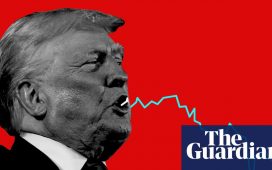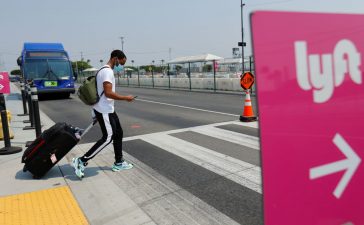Beyond the padlocked metal gate, beyond the silent train crossing, lie 4.8mn square feet of concrete — weeds and saplings pressing through the cracks, rubble heaped on the ground, environmental dangers lurking in the soil.
The immense site, especially dreary on the hard-rain, late-winter morning when I was back in Janesville, was the home of General Motors’ oldest assembly plant, long the heart and economic soul of this small southern Wisconsin city. In its heyday a half-century ago, the Janesville Assembly Plant boasted 7,000 workers. Even when the last Chevy Tahoe rolled off the assembly line two days before Christmas 2008, about 3,000 GM’ers were still there that final year to lose their well-paid jobs, and the factory’s closing and the bad economy swept away thousands of other jobs nearby.
I had first come to Janesville as the US was creeping out of the Great Recession. I was looking for a spot to write a close-up of what happens to a perfectly ordinary place when good work goes away, and this county seat surrounded by farmland about 100 miles north-west of Chicago seemed promising. I spent several years getting to know auto-working families stung by the disappearance of jobs, community leaders trying to coax the city out of the economic trauma, and the shifting texture of Janesville itself.

Falling out of the middle class, I learnt, is not the same as having been poor all along, bruising people’s identity along with their standard of living. Job retraining, I found, was not always a panacea. And as the 2016 election cycle was bringing Donald Trump to the fore, I saw the kind of post-industrial distress that was attracting voters elsewhere to his flavour of populism — even as Janesville remained a Democratic-leaning union town.
Now, seven years after my book Janesville came out, as the rain clattered on my rental car, I wondered what lessons this place might yield about the US economy and communities’ hopes in today’s starkly different time. If this small city in America’s heartland served as a handy microcosm of what happened during the recession of 2007 to 2009, what could it tell us about the kinds of jobs America has been spawning lately, the geography of industrial development, the expectations that Biden administration policies have infused in another election year among communities where traditional industry has become merely a memory?
What I found was a reminder that, often, more than one thing can be true at once. This small city has a plucky, resilient streak, so I was not surprised to hear while I was back in town an overt pride in its considerable recovery. And yet, that is not its only trajectory. The present-day story of Janesville also illustrates US manufacturing’s waning and, in particular, the difficulty of finding fresh uses for the auto plants the country has abandoned.
The recovery is reflected in a few data points. Despite the economic blow, the city did not become a ghost town, its population of 63,000 when the assembly plant shut down having crept up by a couple of thousand people. The supply of jobs and the share of the labour force that is working are healthy now, mirroring the US national picture. Unemployment, which had soared above 13 per cent in 2009, is negligible. In March, the month I returned, it was sitting at 3.7 per cent, about the same as the Midwest overall and a smidgen lower than that month’s US average.
What Janesville went through is classic deindustrialisation, and manufacturing certainly has ebbed; it accounts for one job in six in Rock County, which includes Janesville — nearly 2,500 fewer manufacturing jobs than just before the assembly plant went still. Its identity as an automaking town ripped away, the local economy has become more diverse. As James Otterstein, the county’s economic development manager for the past quarter-century, told me: “It takes 20 to 30 employers to replace the vacancy created by the GM machine.” Some new businesses have arrived, including a Dollar General distribution centre that drew thousands of applicants for about 500 advertised jobs when it opened several years ago. Some longtime businesses have grown. And along Main Street, fewer storefronts are vacant, with a block of historic brick structures now including a wine bar and a shop specialising in olive oils.
Amid this are a few wrinkles. Almost none of the jobs added in town lately are unionised and so lack the generous benefits — including days off for hunting season — that GM furnished. Wages are another matter. Even today, Otterstein estimates, fewer than a thousand people in town are earning around the $28 an hour that GM was paying back when the plant closed. And while wages have been rising recently, inflation has been tempering the practical value of such gains, the way it has around the country.

This replacement of good-pay jobs with lesser-pay jobs has not stirred much bitterness. As Stan Milam, a retired Janesville journalist who grew up the son of a GM’er, told me, enough time has passed that much of today’s workforce never was at the assembly plant. “They are more or less dealing with the present, and, if you can make $20 an hour, you’re OK,” Milam said. “Most of those people don’t know what ‘used to be’ was.”
A different wrinkle involves the slight friction that has long existed between Janesville’s haves (their own livelihoods spared by the end of automaking), concentrated in the city’s northern and eastern neighbourhoods, and its have-nots (whose middle-class lifestyles collapsed along with the assembly plant), living mostly in southern and western parts of town.
The biggest new fact and symbol of this persistent friction is an ice arena and convention centre now under construction where a Sears department store was torn down, along the commercial strip stretching north from downtown. To build it, the city is borrowing a huge sum — $17mn — blended with private donations and federal money that Wisconsin, like all states, received to help cope with a more recent blow: the pandemic’s economic effects. Wisconsin’s governor, Tony Evers, was at the ribbon-cutting a few months ago and said the project “will bring unlimited opportunities to the Janesville area”, including crowds to watch a professional ice hockey team.

Still, Rich Gruber, a former Janesville city council president, is among those who see this sports and convention centre as controversial. The investment of so much public money on the north part of town stirs old resentments, especially when it’s been several years since the south end lost Pick ’n Save, its only grocery store.
Even so, Gruber told me the community “is very robust, compared with how solemn and depressing it was in ’08, ’09, ’10.”
Dennis Winters, the chief economist for Wisconsin’s Department of Workforce Development, told me he regards the city as a comeback story.
This fairly upbeat scenario is one way of understanding what has been happening in Janesville. And yet there is the other reality: the GM-plant-sized vacancy on the south side of town. The last time I’d been in Janesville, before the coronavirus pandemic, bulldozers belonging to a company that had bought the GM property were lumbering across the site, razing the factory that had begun turning out Chevrolets on Valentine’s Day 1923.
Community members could pick up old plant bricks that the new owner, a St Louis-based company specialising in distressed industrial land, gave away as a souvenir of its storied past. Not long after I’d glimpsed the demolition, the company and the city government aligned in a vision for the vast tract’s rebirth as Centennial Industrial Park. Yet, five years after I’d last looked upon the site, there has been no rebirth.
The bleak vacantness lingers as an economic and psychic wound. At 80, Tim Cullen recognises this as well as anyone. He worked his way through college with summer jobs at the assembly plant, the third generation of GM men in his family. He became a state senator, co-led a state task force that tried and failed to save the plant, and eventually wrote his own book about the plant’s history and meaning to the city. Over lunch, he told me, the site “is a reminder of what once was, and now there’s nothing, and nothing isn’t very attractive. It’s ugly”.
Kevin Lahner, having arrived just a year ago as Janesville’s city manager — the top local government official — recognises the same thing. “To know . . . how connected the city was to that plant and see how it is today,” he said, “is heartbreaking.”
The heartbreak is especially sharp among those old enough to have first-hand memories of ways the assembly plant used to order the city’s rhythms, with local radio news timed to shift changes, grocery prices pegged to GM pay rises, United Auto Workers Local 95 a reliable source of community fundraisers.
So why, in this resilient little city that has managed to create new jobs, is the colossus of an old GM site — with its notable advantages of two railroad lines, ample electricity and a road named after a legendary US labour leader connecting the property to an Interstate highway — still idle?
Part of the answer is the sobering context. If you look at the fates of closed auto plants that have dotted the US, finding new purposes for such huge tracts of land is usually hard and slow. And the geography of industrial investment has migrated, with the South and its anti-union culture — no longer the upper Midwest, including Wisconsin — increasingly the heart of America’s manufacturing. Plus, newfangled manufacturing seldom requires the scale of Janesville’s 250-acre GM site. “It’s going to be harder and harder to find someone to come to an old auto site,” says K Venkatesh Prasad, senior vice-president of research at the Center for Automotive Research in Michigan.
I asked Bruce Rasher to calculate for me the time that typically elapses between putting a shuttered auto site up for sale and someone buying it. The median turns out to be almost six and a half years. If anyone has a clear-eyed view of what it takes to reuse a closed American auto plant, Rasher is the person. Since 2011, he has been the development manager of something called the Racer Trust, an independent organisation formed by a court after GM declared bankruptcy near the Great Recession’s end. Racer was handed responsibility for cleaning up and otherwise getting ready for redevelopment some 83 locations in 14 states that were idled as part of the bankruptcy. Janesville was not among them because, until 2015 — seven years after production stopped — it remained in limbo, with GM saying it might reopen if circumstances warranted.
Even with federal money paying for environmental clean-up of the Racer locations, Rasher told me, “It’s very difficult. There are a lot of obstacles to redevelopment.” Of the 83 locations, Rasher has found buyers over the years for 46 in full so far. To find those buyers, he has vetted about 30 prospects per location. According to the Center for Automotive Research, seven other auto plants — GM and Chrysler — shut down within months of Janesville. Eventually, these others have found new uses. The one that sat empty longest held its grand opening last autumn as one of Georgia’s largest television and movie production studios.


Why has Janesville’s trajectory, so far, been different? It turns out that the barren site is at the crossroads of two disputes. One dispute involves environmental contaminants. Under the concrete cap where the plant stood, pollutants have been leaching for generations into the soil and the adjacent Rock River sediment, including metals from cars so defective while being made that they were tossed into a huge pit. Wisconsin’s environment agency has ruled that, as long as the concrete remains in place, the property has been decontaminated enough for new industrial uses. The city government, however, has its own, stricter rules that would require any business interested in developing the property to destroy the concrete slab and remove the toxins underneath — a deterrent to would-be developers choosing where to locate.
If one dispute revolves around pollution standards, the other is a dispute over hope — a debate over what future is good enough, which is familiar in many deindustrialised communities. In Janesville, the dispute pits the site’s owner, Commercial Development Company, against the city government. Stephen Collins, CDC’s executive vice-president, says the company has co-operated with the city, including paying for the study five years ago that relied on local architects and engineers to devise the Centennial Industrial Park plan. Since then, Collins said, the company has brought a handful of prospects to the city government, the most serious of which would have been a terminal to move shipping containers between different modes of transport. City planners never even put the proposal on their agenda.
“To say we haven’t brought anything forward is inaccurate,” Collins told me. Lahner, the city manager, has quite a different view. CDC, he contends, “is not invested in the outcomes of this project”. With unattractive proposals, disputed back taxes and fees, and rubble piles that make the site “look like crap”, the city manager says, “Honestly, I just think the property got sold to the wrong group.”
As Lahner sees things, the site’s industrial history does not need to dictate its destiny. Its future, he told me, could perhaps be a data centre, with new homes and nice public spaces.
The city’s ambitions have been stoked in part by the economic policies of President Joe Biden, now campaigning for re-election, who pushed through Congress laws to promote infrastructure and new technologies. Just last month, the president visited another small Wisconsin city, about 60 miles east of Janesville, to announce the creation of an artificial intelligence data centre by Microsoft — part of the White House’s “Investing in America” agenda.
The catch is, as new federal money has begun flowing from the recent laws to spur the economy, Janesville has not benefited. When the US Commerce Department last October announced grants to 31 regional “tech hubs”, the larger Wisconsin cities of Madison and Milwaukee were on the list. Without a major research university or a large white-collar workforce, said Otterstein, the county economic development manager, Janesville was not eligible to apply. He sees billions of federal dollars from the 2022 Chips and Science Act flowing to Phoenix to expand the semiconductor industry there. “If the federal government would have stepped forward to say, ‘We are going to drive a chip manufacturer specifically to the upper Midwest and locations that are dormant industrial plants . . .’” Otterstein said, “I’m not suggesting our property would have risen to the top, but at least we would have been in the conversation.”
So, what now? In the year since he arrived, Lahner has become the main mover behind an unusual act of local government: a plan to condemn the old GM site and buy it from its owner. If the city owned the property, he figures, it could draw on state and federal money to finish the clean-up. In February, the city council voted to take the first steps, assessing the land’s value. No one knows yet what this plan would cost city taxpayers.

CDC has been buying and selling distressed, often polluted industrial land for three decades — 300 sites in all. Over the years, Collins said, he has found “the market decides what is going to happen”. In other words, he questions whether Lahner’s aspirations are realistic. Still, Collins told me: “If they want to pursue that, we don’t want to stand in the way, as long as they pay a fair price.”
Lahner acknowledges that his vision is going to be hard, long and expensive, requiring millions of dollars to remove the toxins and perhaps five to 10 years more for the site’s rebirth.
In the meantime, Janesville turns out once again to be a metaphor — this time for a moment when jobs have become plentiful. Yet the centrepiece of the town’s industrial identity for nearly a century remains vacant and scarred.

Amy Goldstein is a visiting fellow at the Brookings Institution and author of ‘Janesville: An American Story’ (Simon & Schuster), which won the 2017 Financial Times and McKinsey Book of the Year. Read our review here
Find out about our latest stories first — follow FT Weekend on Instagram and X, and subscribe to our podcast Life & Art wherever you listen










